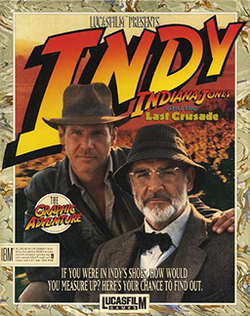Indiana Jones and the Last Crusade: The Graphic Adventure
| Indiana Jones and the Last Crusade | |
|---|---|

DOS Cover art
|
|
| Developer(s) | Lucasfilm Games |
| Publisher(s) | Lucasfilm Games |
| Designer(s) |
Ron Gilbert Noah Falstein David Fox |
| Artist(s) |
Steve Purcell Martin Cameron James A. Dollar Mike Ebert James McLeod |
| Composer(s) | Eric Hammond Dave Warhol, James Leiterman (FM Towns) |
| Engine | SCUMM |
| Platform(s) | DOS, Amiga, Atari ST, Macintosh, FM Towns, Amiga CDTV |
| Release |
July 1989: DOS, Amiga, Atari ST |
| Genre(s) | Adventure game |
| Mode(s) | Single player |
July 1989: DOS, Amiga, Atari ST
1990: Macintosh, FM Towns[1]
1992: Amiga CDTV
Indiana Jones and the Last Crusade: The Graphic Adventure is a graphic adventure game, originally released in 1989 (to coincide with the release of the film of the same name), published by Lucasfilm Games (now LucasArts). It was the third game to use the SCUMM engine.
Last Crusade was one of the most innovative of the LucasArts adventures. It expanded on LucasArts' traditional adventure game structure by including a flexible point system—the IQ score, or "Indy Quotient"—and by allowing the game to be completed in several different ways. The point system was similar to that of Sierra's adventure games, however when the game was restarted or restored, the total IQ of your previous game was retained. The only way to reach the maximum IQ of 800 was by finding alternative solutions to puzzles, such as fighting a guard instead of avoiding him. This countered one common criticism of adventures games, whereby since there is only one way to finish the game, they have no replay value. Some of the alternative fights, such as the one with the Zeppelin attendant, were very difficult to pass, so the maximum IQ was very difficult to acquire.
A replica of Henry Jones' Grail diary was included with earlier versions of the game. While very different from the film's version, it provided a collection of background information of Indy's youth and Henry's life. The diary was also necessary to solve puzzles near the end of the game, most notably to identify the real Grail. Later versions of the game came with a shortened version of the Grail diary. The diary gave Indy's mother's name as Mary, which was contradicted by subsequent canon.
The plot closely follows, and expands upon, the film of Indiana Jones and the Last Crusade. As the game begins, Indiana Jones has returned to his college, after reclaiming the Cross of Coronado. He is approached by businessman Walter Donovan, who tells him about the Holy Grail, and of the disappearance of Indy's father.
...
Wikipedia
